

Invisibles, Not Wearables, Will Profoundly Change Health Care. This Startup Will Make You A Personalized Health Plan Based On Your Genes. When the FDA ordered 23andMe to stop giving customers medical information based on their DNA, they unintentionally opened a new market niche.
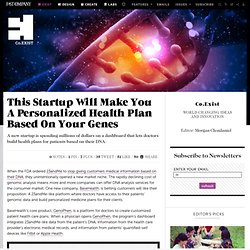
The rapidly declining cost of genomic analysis means more and more companies can offer DNA analysis services for the consumer market. One new company, BaseHealth, is betting customers will like their proposition: A 23andMe-like platform where doctors have access to their patients’ genomic data and build personalized medicine plans for their clients. BaseHealth’s core product, GenoPhen, is a platform for doctors to create customized patient health care plans. When a physician opens GenoPhen, the program’s dashboard integrates 23andMe-like data from the patient’s DNA, information from the health care provider’s electronic medical records, and information from patients’ quantified-self devices like Fitbit or Apple Health.
"Existing health assessment platforms out there do not support personalized action plans. Data And Your Doctor Are Coming Together To Revolutionize Health Care. Considering your own medical data, try answering a few questions: What was your blood pressure this morning?
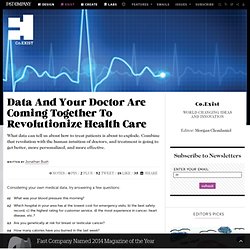
Which hospital in your area has a) the lowest cost for emergency visits, b) the best safety record, c) the highest rating for customer service, d) the most experience in cancer, heart disease, etc.? Are you genetically at risk for breast or testicular cancer? 09_Safaricom. Deciding upon a single typeface to get your point across is easy, but figuring out which typefaces match is something even design experts often get wrong.
How do you find the chocolate to Perpetua's peanut butter then, or the goose to Garamond's gander? You put them through the paces of the Type Connection, a typographic dating game. It's actually far less silly than you'd expect. Designer Aura Seltzer, a Maryland College Institute of Art MFA student who created The Type Connection for her thesis project, explains how it works: Doctors-salaries-are-not-the-big-cost.html?smid=fb-nytimes&WT.z_sma=OP_MTE_20140519&bicmp=AD&bicmlukp=WT. America’s overcrowded prisons: One nation, behind bars. MC10's BioStamp: The New Frontier of Medical Diagnostics.
The age of wearable computing is upon us: There are now wristbands from Nike (NKE), clip-on devices from Fitbit, and eyewear from Google (GOOG).

We’ve come this far because we’ve been able to shrink computing power from something the size of a room to a box that sat atop a desk, to a smaller box that fits in the palm of our hand, to now an even smaller box we can wear on our bodies. But they’re still boxes, more or less: Rigid devices that stick out because they don’t conform to the human shape. All Of The Gruesome Ways That Smoking Changes Your Body. If the prospect of lung cancer doesn’t get you down, a new interactive web tool shows people loud and clear the myriad of effects that smoking will have on their bodies, from more acne and worse breath to increased arm hair (for women) to a lower sperm count (for men).
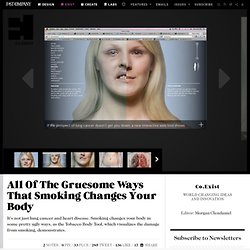
Kids, this is your body on tobacco. The web tool, called Tobacco Body, was developed by Cancer Society of Finland and the creative agency 358. With zooms and a slider, it allows visitors to view effects on males or females, and then explore how the body of a smoker changes compared to a non-smoker. Since the site started getting international media attention a month ago, 3.5 million people have visited the site. Among anti-smoking advocates, there’s a growing interest in really showing what smoking does to physical appearances as much as health effects.
This Smart Sleep Mask Helps You Rest Better in Less Time ⚙ Co. Studies say up to a quarter of Americans don’t get enough sleep, and there’s no shortage of articles about how to function better with power naps and elaborate “polyphasic” sleep-and-wake cycles.
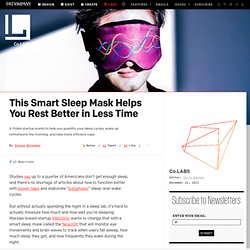
But without actually spending the night in a sleep lab, it’s hard to actually measure how much and how well you’re sleeping. Warsaw-based startup Intelclinic wants to change that with a smart sleep mask called the NeuroOn that will monitor eye movements and brain waves to track when users fall asleep, how much sleep they get, and how frequently they wake during the night.
Intelclinic’s raised more than $200,000 so far through an ongoing Kickstarter effort to fund production and further development of the NeuroOn masks, and the company aims to start getting masks to Kickstarter backers in Spring 2014, said founder and CEO Kamil Adamczyk. Users will be able to monitor their sleep schedules through an iPhone or Android app. There Is A Huge Underground Farm Hiding 100 Feet Beneath London's Streets. The newest branch line of the London Underground doesn't go anywhere.

But it does produce a lot of nice food to eat. Could The Future Of Health Care Mean No Waits In Hospitals? There’s a video featuring the Kaiser Foundation that I found one day when I was perusing YouTube for insight on how the vision of the hospital has morphed over time.
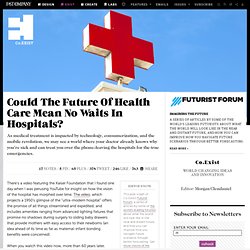
Infographic: How People Died In The 20th Century. Statistically speaking, you may be likely to die of a different ailment than your grandfather (or great-grandfather).

Death evolves alongside life, as medicine improves and lifestyles shift.
Alanna Shaikh: Cómo me estoy preparando para tener Alzheimer. El Dr. Seyi Oyesola recorre un hospital en Nigeria. A. J. Jacobs: como la vida saludable casi me mata. Marvin Minsky habla sobre la salud y la mente humana. Bill Davenhall: Tu salud depende del lugar donde vives. The future of medicine. All kinds of minds. Vikram Patel: salud mental para todos involucrando a todos. The Five Biggest Ideas On The Future Of Health Care Design. Every year, the biggest ideas in health care are presented at the Mayo Clinic’s Transform conference in Rochester, Minnesota.

I was there this year to present a pre-conference workshop with a Continuum colleague on everyday creativity, and another pair of Continuum designers gave a main-stage talk entitled, “Patient Centricity: A design identity crisis.” Also on the lineup were John Hockenberry and Roger Martin, bigwigs from J+J and GE Healthcare, and practitioners from the top-tier design and innovation firms. Many cutting-edge ideas were presented, along with some spirited debate on the hot topics of delivering care and the role of technology. Here are my top five conference takeaways on the future design of health care. Elizabeth Pisani: Sexo, drogas y VIH. John Wilbanks: Hagamos un patrimonio común con nuestros datos médicos. Eric Dishman: Eliminar la Asistencia Médica del sistema central.
Ernest Madu habla de la asistencia médica de talla mundial. Infographic of the Day: Where the Jobs Will Be in 2018. As part of a series looking at employment trends for the coming decade, NPR has created an interactive chart summarizing their findings: You've got to go to the actual graph to see the data, but once you do, the message is clear: White-collar service jobs will be huge.

The fastest growing sectors there will be computer systems design and technical consulting, at 43% and 81% respectively. But the most troubling facet of the graph is the growth in health care, where jobs will expand by 19%. (As the Congressional Budget Office has shown, health care will become 25% of the GDP by 2025 if current growth rates persist.) Why is that troubling? And that points to one of the most difficult things about health care reform: The effects of the current bills before Congress and the Senate have been sold variously as an ethical mandate to provide health care to all and a cost-saving measure aimed at curbing growth that will eventually cripple the economy. Infographic: We’re Living Longer, But Less Healthily Too. When we hope to live to 100, it’s through a montage of quiet, joyful moments--enjoying a day on the porch or sitting with grandkids. No one’s goal is to reach the centennial mark bedridden or tethered to machines.
Unfortunately, as a fascinating infographic by Bonnie Berkowitz, Emily Chow, and Todd Lindeman for The Washington Post points out, while people are living longer than they used to, the percentage of our time living (and dealing) with disease is growing as well. We’re living longer, worse lives. Fathom. The Biggest Opportunity For Disruption Today: Health Care Products That Work. The holiday season may be over, but the time spent with friends and family may still be fresh. In all the gatherings, I would bet you had at least one conversation about health--your diet for 2012, a friend’s pledge to exercise more, Mom’s rehab from her surgery, Dad’s long list of medications. It is impossible to escape that time of year without thinking about health; whether you are fortunate to have good health, or hoping this year will bring it.
The good news is 2012 will be the year of good health--at least in the world of design and technology. Where I live in Silicon Valley, many people believe home health will be the next big boom. The Rock Health incubator is churning out a slew of startups that will help you manage your health, the iPhone 5 is expected to launch with a built-in heart rate monitor, and sick people everywhere will begin to look at health care more as consumers than as patients.
Creating a Post-Crisis Economy: Control Your Own Health Care. In the U.K. in the 1940s, Sir William Beveridge designed what became known as the welfare state. In an ambitious program, the post-war Labor government attempted to put in place a series of services designed to ensure that the population of Britain could reliably receive high-quality public education, health care and other public services. Beveridge envisioned a system in which citizens participated directly in their own well-being. Instead, he helped create what he later described as a "culture of consumption" of public services. Here in the U.S., a "culture of consumption" is exactly what we have when it comes to health care. The third-party payer system (whether it is private insurance or government) has created passive consumers of health-care services who have little motivation to engage, and bloated, bureaucratic service providers who have little motivation to become more efficient.
Creating a Patient-Centered Future for Health Care [Video] When it comes to designing new medical devices, most of the talk is about how easy products are for physicians to use, noted designer Kai Worrell at last week's Body Computing conference at USC. There's almost no conversation about the experience from the patients' perspective, he said -- a shift which could radically change the health care industry. Worrell's Minneapolis-based firm has spent the past few years talking with patients, visiting their homes, and getting to know the needs of these stakeholders as they've designed health care products. Jawbone Announces Up, A Wristband To Track Health, Fight Obesity. Infographic: Red Meat Is Killing Us. How Graphic Design Can Help Keep HIV From Spreading.
Infographic of the Day: Who, Exactly, Supports a Public Option? This is a big week in the decades-long debate over providing health care to the uninsured: Both the House and Senate are expected to deliver their reform bills. With Bedsider, IDEO Aims To Curb Unplanned Pregnancy Using Videos, Smartphones, And Sass. How We're Botching Our Attempts to Redesign the Health Care System. Designed For Health? The Hospital As Boutique Hotel. Heart-Monitor iPhone App Works By Scanning The Blood In Your Face. Architecture In The Exam Room: An Exhibition Exploring Design And Medicine. Doctors often talk about disease in terms of cities: Cancer cells are rogue factories, while parasites are invaders. Likewise, urban planners and architects have long talked about design in relationship to medicine and disease.
Evidence-Based Clinical Decision Support at the Point of Care. Infographic Of The Day: Ben Fry And GE Bring Health Care Crisis To iPad. What If You Could Gauge Your Health With Color-Coded Poo? For the Future of Health Care Design, Look Beyond the Hospital. 5 Trends That Will Shape Digital Services In 2013. The White House Reveals A Redesigned Electronic Medical Record. Diagnosis: FAIL. Poorly Designed Tech Infects Health-Care Industry. Designing the Perfect Health Care Clinic. Infographic: Lack of Health Care vs. Terrorism, Which Kills More? Infographic of the Day: Flow Chart of Obama's Health-Care Plan. Massive Health iPhone App Gets You To Eat Better, Using The Crowd's IQ. 8 Incredible Health Innovations That Transform Lives. Jawbone Releases UP, A Wristband For Tracking Your Wellness. Steelcase Reinvents the Hospital Cart for the Health Care Revolution.